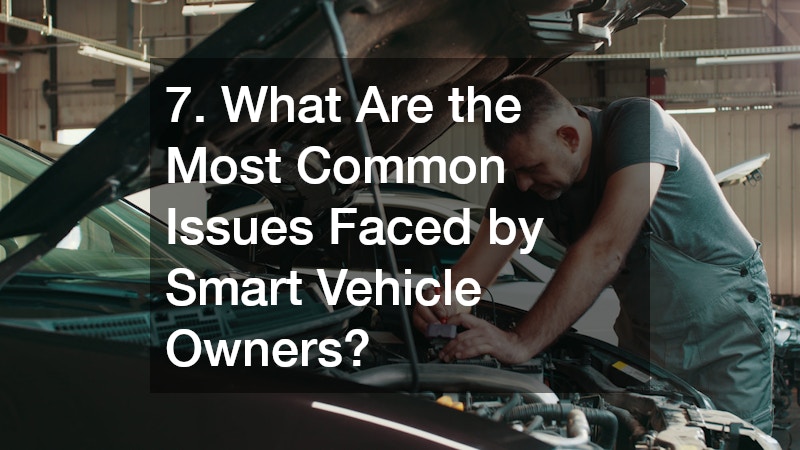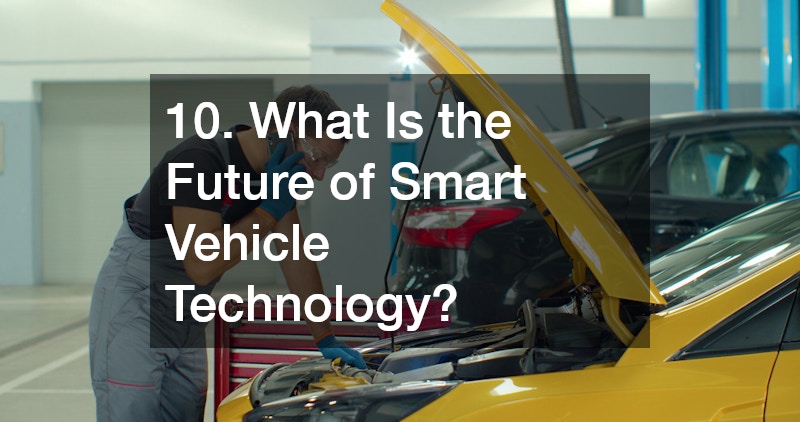
The rapid advancement of technology in the automotive industry has transformed how we drive, maintain, and interact with our vehicles. Today’s cars are equipped with advanced sensors, artificial intelligence, and connectivity features that make them safer, more efficient, and more convenient than ever before. Smart vehicles are no longer just luxury items—they’ve become a significant part of modern transportation, offering both innovation and practicality.
However, owning a smart vehicle also brings new responsibilities. From understanding advanced systems and performing proper maintenance to adhering to new legal and safety standards, smart vehicle ownership requires a proactive and informed approach. Many of these vehicles collect and process data in real-time, meaning that owners must stay aware of both mechanical and digital upkeep.
This article explores the key aspects of smart vehicle ownership, including how they work, how to maintain them properly, the importance of safety features, and the legal obligations owners must meet. Whether you already own a smart vehicle or are considering purchasing one, this comprehensive guide will help you navigate the balance between innovation and responsibility.
1. What Are Smart Vehicles and How Do They Work?

Smart vehicles represent the intersection of automotive engineering and digital technology. Unlike traditional cars, these vehicles utilize advanced sensors, cameras, radar, GPS, and onboard computers to assist drivers and enhance the driving experience. They often include adaptive cruise control, lane departure warnings, and even semi-autonomous driving capabilities.
The key to understanding how smart vehicles work lies in their networked systems. Each feature communicates through a central processing unit, allowing the vehicle to analyze data in real time. This enables faster reactions to environmental changes—such as adjusting speed in heavy traffic or braking to avoid collisions.
In addition to hardware, software plays a crucial role in keeping smart vehicles operational. Regular updates are required to maintain performance, fix bugs, and improve safety algorithms. Some updates are automatic through wireless connections, while others require visits to specialized service centers.
One area often overlooked in smart vehicle care is visibility. High-tech cars depend heavily on sensors and cameras, which can be affected by damage or obstruction. Ensuring these remain unobstructed is vital for optimal function. In cases of cracked or damaged windshields, auto glass replacement becomes more than just a cosmetic repair—it’s essential for maintaining the accuracy of the vehicle’s vision and safety systems.
2. How to Properly Maintain a Smart Vehicle?
Proper maintenance is critical to keeping smart vehicles performing at their best. These cars contain complex components, from advanced engines to integrated digital systems that require specialized attention. Unlike traditional maintenance routines, smart vehicles demand a combination of mechanical expertise and software management.
Start by following the manufacturer’s maintenance schedule closely. Regular inspections of brakes, tires, and fluid levels are essential, but smart vehicles also require system diagnostics to ensure sensors, cameras, and communication modules are functioning correctly. Software updates should never be ignored, as they can enhance fuel efficiency, improve performance, and fix vulnerabilities.
Routine checks at reputable car repair shops familiar with smart vehicle technology are highly recommended. These shops often have certified technicians who can interpret digital diagnostic reports and identify potential issues before they become costly problems.
Owners should also take advantage of mobile apps that monitor vehicle performance and send alerts when maintenance is due. Keeping firmware and software up to date ensures that your car remains safe, efficient, and compatible with evolving technology.
3. What Are the Common Safety Features in Smart Vehicles?
Safety is one of the most significant benefits of smart vehicle technology. Manufacturers have integrated innovative systems designed to protect both drivers and passengers, reducing accidents and improving overall road safety.
Some of the most common safety features include adaptive cruise control, lane-keeping assistance, automatic emergency braking, and blind-spot detection. These technologies rely on sensors and cameras to detect surrounding conditions and assist in preventing collisions.
Additionally, smart vehicles often include driver monitoring systems that track head movement and alertness, ensuring that the driver remains focused on the road. Real-time diagnostics also help detect issues before they compromise safety.
Auto repair specialists play a vital role in ensuring these systems function correctly. Regular calibration and inspection of radar sensors and cameras are crucial, especially after an accident or windshield repair. If these sensors become misaligned, even the most advanced safety systems may fail to perform as intended.
4. How Do Smart Vehicles Enhance Driver Safety?

Smart vehicles enhance driver safety by blending technology with human control. Features like automatic braking, adaptive headlights, and collision avoidance systems work behind the scenes to reduce driver error—one of the leading causes of accidents.
These systems constantly monitor the vehicle’s surroundings, analyzing data to make split-second adjustments that protect both the driver and passengers. For example, smart cars can automatically adjust following distances in traffic or alert the driver to a potential hazard before it becomes critical.
Furthermore, vehicle-to-vehicle (V2V) and vehicle-to-infrastructure (V2I) communication technologies are becoming increasingly common. These systems allow smart vehicles to exchange information with other cars and traffic systems, predicting road conditions and preventing accidents before they occur.
However, even with these advancements, proper coverage from an auto insurance service remains essential. Insurance providers often offer discounts for vehicles equipped with safety technology due to their lower risk of accidents. Reviewing your policy ensures that all smart features and repair costs are adequately covered.
5. What Are the Legal Responsibilities of Smart Vehicle Owners?
Owning a smart vehicle introduces new legal considerations. Beyond traditional obligations like registration, insurance, and emissions compliance, smart vehicles require additional attention due to their data collection capabilities and autonomous features.
Owners are responsible for maintaining their vehicle’s software updates and ensuring all systems comply with safety regulations. Neglecting updates can sometimes result in reduced functionality or even legal liability if outdated systems contribute to an accident.
Data privacy is another growing concern. Smart vehicles store and transmit information about driving habits, routes, and personal data. Understanding privacy policies and how manufacturers handle this information is crucial for protecting your rights.
If your smart car becomes inoperable or outdated, options like cash for junk cars programs allow owners to dispose of or sell their vehicles responsibly. These services ensure that valuable components, especially electronic ones, are recycled or repurposed safely.
As laws surrounding autonomous driving continue to evolve, staying informed about local regulations is vital. Understanding your responsibilities as a vehicle owner helps you remain compliant and ensures safe operation on public roads.
6. How Can Smart Vehicles Improve Fuel Efficiency?
Fuel efficiency has always been a priority for vehicle owners, and smart technology has revolutionized how efficiency is achieved. Smart vehicles use sensors and predictive algorithms to optimize driving performance, reduce fuel waste, and improve energy management.
Features like adaptive cruise control, automatic start-stop systems, and energy recovery during braking contribute significantly to better fuel economy. Additionally, hybrid and electric smart vehicles analyze driving patterns to maximize range and minimize energy loss.
Some vehicles use GPS-based route optimization to suggest the most efficient paths based on traffic and terrain. Real-time feedback encourages eco-friendly driving habits by monitoring acceleration, braking, and speed consistency.
In the event of an accident caused by inefficiency-related malfunctions, auto accident lawyers can assist in handling disputes or claims related to mechanical failures or defective parts. They ensure your rights are protected if manufacturer negligence or software errors contribute to performance issues.
Ultimately, smart vehicles not only help reduce fuel consumption but also contribute to environmental sustainability. Understanding and leveraging these technologies ensures long-term savings and a smaller carbon footprint.
7. What Are the Most Common Issues Faced by Smart Vehicle Owners?

While smart vehicles offer numerous advantages, they also come with challenges that traditional cars do not face. Common issues include software glitches, sensor malfunctions, connectivity errors, and expensive repairs due to specialized components.
Software-related issues can sometimes cause malfunctions in safety or navigation systems. These problems may require professional attention or remote updates from manufacturers. Connectivity issues, such as failed Bluetooth pairing or interrupted GPS, are also frequent concerns.
Regular auto maintenance remains the best defense against these problems. Ensuring your systems are updated and components are regularly inspected helps prevent small issues from turning into costly repairs. Some manufacturers provide online diagnostic tools that can alert owners to potential problems before they occur.
Another common issue is cost. Repairs for smart vehicles can be significantly higher than for traditional models due to advanced parts and software expertise. Extended warranties or maintenance plans can help mitigate these expenses and provide long-term peace of mind.
Understanding these challenges allows owners to be proactive, ensuring their smart vehicles remain reliable and efficient throughout their lifespan.
8. How Do You Troubleshoot a Smart Vehicle?
Troubleshooting a smart vehicle requires both mechanical and digital awareness. Unlike older cars, which rely primarily on manual diagnostics, modern vehicles often provide error codes or alerts through dashboard displays and mobile apps.
When a problem arises, start by checking for software updates or system notifications. Many issues can be resolved through a simple reboot or by updating the car’s firmware. If the issue persists, consult your vehicle’s manual to understand warning symbols and take appropriate action.
Climate control systems are a common area of concern. If your smart car’s heating or cooling isn’t functioning properly, professional auto air conditioning repair may be required. This ensures that sensors and climate modules are recalibrated correctly without affecting other electrical systems.
Smart vehicle owners should also learn how to perform basic resets and data clears for minor glitches. However, avoid tampering with internal software or sensor systems, as doing so could void warranties or cause further complications.
For persistent or complex problems, always seek assistance from certified professionals. Advanced diagnostic tools can identify specific faults quickly, saving time and preventing unnecessary expenses.
9. What Role Do Smart Vehicles Play in Driving Automation?
Driving automation represents the next stage in automotive innovation. Smart vehicles are at the forefront of this evolution, gradually transitioning from driver assistance systems to fully autonomous driving.
Automation is categorized into levels, ranging from Level 0 (no automation) to Level 5 (full automation). Most modern smart vehicles fall within Levels 2–3, featuring adaptive cruise control, lane centering, and limited self-driving capabilities under specific conditions.
The success of automation relies on real-time data collected by sensors, cameras, and radar systems. These components work together to analyze surroundings, recognize traffic signs, and predict other drivers’ movements.
Interestingly, automation isn’t limited to small passenger cars. Heavy-duty vehicles, including those using truck tarps for cargo protection, are also integrating smart technologies. Automated braking, lane assistance, and telematics systems enhance fleet efficiency and reduce accidents in the logistics industry.
While the future promises safer and more efficient roads, it’s essential for drivers to remain alert and prepared to take control when necessary. As laws and technologies evolve, the partnership between human and machine will continue to redefine how we experience transportation.
10. What Is the Future of Smart Vehicle Technology?

The future of smart vehicle technology is filled with possibilities. Innovations in artificial intelligence, connectivity, and renewable energy are driving the automotive industry toward safer, cleaner, and more efficient transportation.
Upcoming advancements include improved self-driving algorithms, enhanced vehicle-to-everything (V2X) communication, and integration with smart city infrastructure. Vehicles will soon be able to communicate directly with traffic lights, road sensors, and other cars to optimize traffic flow and reduce congestion.
Electric and hybrid smart vehicles will continue to dominate as sustainability becomes a global priority. Enhanced battery life, faster charging, and renewable energy integration will further improve convenience and reduce environmental impact.
However, with greater connectivity comes increased responsibility. Data protection, cybersecurity, and legal accountability will become crucial elements of vehicle ownership. In cases involving accidents or liability disputes, consulting a motorcycle accident attorney can provide insights into handling emerging legal issues tied to automation and digital evidence.
Ultimately, the future of smart vehicle technology is about creating harmony between human intelligence and machine precision. As these systems evolve, staying informed and adaptable will ensure that owners continue to drive safely, efficiently, and responsibly.
By understanding how smart vehicles function, adhering to maintenance schedules, and embracing safety technologies, drivers can enjoy a seamless and secure driving experience. Equally important is staying informed about legal requirements and emerging technologies that influence vehicle ownership.
As innovation continues to reshape transportation, the most successful vehicle owners will be those who balance convenience with caution, ensuring their vehicles operate safely and efficiently in the ever-evolving landscape of modern mobility.



